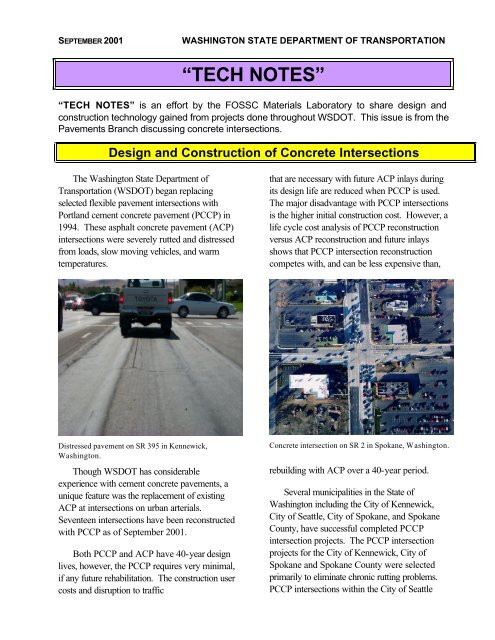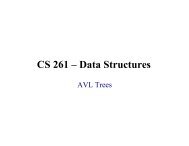WSDOT Rigid Pavement Intersection Tech Note - Classes
WSDOT Rigid Pavement Intersection Tech Note - Classes
WSDOT Rigid Pavement Intersection Tech Note - Classes
You also want an ePaper? Increase the reach of your titles
YUMPU automatically turns print PDFs into web optimized ePapers that Google loves.
SEPTEMBER 2001<br />
WASHINGTON STATE DEPARTMENT OF TRANSPORTATION<br />
“TECH NOTES”<br />
“TECH NOTES” is an effort by the FOSSC Materials Laboratory to share design and<br />
construction technology gained from projects done throughout <strong>WSDOT</strong>. This issue is from the<br />
<strong>Pavement</strong>s Branch discussing concrete intersections.<br />
Design and Construction of Concrete <strong>Intersection</strong>s<br />
The Washington State Department of<br />
Transportation (<strong>WSDOT</strong>) began replacing<br />
selected flexible pavement intersections with<br />
Portland cement concrete pavement (PCCP) in<br />
1994. These asphalt concrete pavement (ACP)<br />
intersections were severely rutted and distressed<br />
from loads, slow moving vehicles, and warm<br />
temperatures.<br />
that are necessary with future ACP inlays during<br />
its design life are reduced when PCCP is used.<br />
The major disadvantage with PCCP intersections<br />
is the higher initial construction cost. However, a<br />
life cycle cost analysis of PCCP reconstruction<br />
versus ACP reconstruction and future inlays<br />
shows that PCCP intersection reconstruction<br />
competes with, and can be less expensive than,<br />
Distressed pavement on SR 395 in Kennewick,<br />
Washington.<br />
Though <strong>WSDOT</strong> has considerable<br />
experience with cement concrete pavements, a<br />
unique feature was the replacement of existing<br />
ACP at intersections on urban arterials.<br />
Seventeen intersections have been reconstructed<br />
with PCCP as of September 2001.<br />
Both PCCP and ACP have 40-year design<br />
lives, however, the PCCP requires very minimal,<br />
if any future rehabilitation. The construction user<br />
costs and disruption to traffic<br />
Concrete intersection on SR 2 in Spokane, Washington.<br />
rebuilding with ACP over a 40-year period.<br />
Several municipalities in the State of<br />
Washington including the City of Kennewick,<br />
City of Seattle, City of Spokane, and Spokane<br />
County, have successful completed PCCP<br />
intersection projects. The PCCP intersection<br />
projects for the City of Kennewick, City of<br />
Spokane and Spokane County were selected<br />
primarily to eliminate chronic rutting problems.<br />
PCCP intersections within the City of Seattle
were a result of its PCCP construction program<br />
on many arterials.<br />
The main reasons for not considering PCCP<br />
reconstruction prior to 1994 was related to<br />
constructibility and concerns about<br />
accommodating high traffic flows through urban<br />
intersections. Rehabilitating urban intersections<br />
with ACP requires rotomilling and inlaying with<br />
ACP to remove wheel rutting. This work can<br />
typically be done at night, in a short period, and<br />
with a minor inconvenience to the public, but must<br />
be performed every eight to ten years or earlier.<br />
On the other hand, rehabilitating intersections with<br />
PCCP usually involves disruption of the<br />
intersection, and can include complete closure of<br />
the intersection or alternating lane closures.<br />
Placement of formwork prior to a PCCP intersection<br />
pour.<br />
The concern within <strong>WSDOT</strong> was that the<br />
inconvenience to the users was too great to<br />
construct urban intersections with PCCP.<br />
However, since 1994, <strong>WSDOT</strong> has shown that<br />
PCCP intersections are constructible and the<br />
early concerns have been overcome. <strong>WSDOT</strong><br />
has built PCCP intersections with an average<br />
daily traffic approaching 37,000 on the major leg<br />
of the intersection.<br />
A comparison of initial PCCP intersection<br />
costs ranged from $455,500 to $982,200 for<br />
PCCP and $349,800 to $728,600 for ACP.<br />
The range in the PCCP or ACP reconstruction<br />
costs resulted primarily from the size and<br />
Placement of concrete using a Whiteman Screed at an<br />
urban intersection.<br />
variability in unit bid prices for each intersection.<br />
Typically, intersection sizes ranged from 4,100 to<br />
6,700 square yards. With the smaller<br />
intersections, the unit bid costs typically<br />
increased, which drives the costs for<br />
reconstruction up. On average, initial<br />
construction costs for full depth PCCP<br />
reconstruction at urban intersections were 25 to<br />
30 percent more than full depth ACP<br />
reconstruction.<br />
The cost per square yard for the initial<br />
PCCP construction ranged from $66 to $148<br />
per square yard, whereas ACP intersection costs<br />
ranged from $51 to $109 per square yard. The<br />
PCCP reconstruction costs were less when the<br />
intersections were reconstructed as part of a<br />
larger asphalt resurfacing project.<br />
The 40-year annualized costs for<br />
intersections show that full depth PCCP<br />
intersection reconstruction is typically less than<br />
full depth ACP reconstruction when future ACP<br />
inlays are accounted for. A study of six of the<br />
intersections reconstructed with concrete<br />
showed that five of the six cost from 6 to 14<br />
percent less than ACP reconstruction (see Table<br />
1 and Figure 1).
In comparison the 40-year annualized cost for<br />
reconstructed PCCP intersections compared to<br />
ACP inlays at four-, six- and eight-year cycles<br />
show that the ACP inlay will always be less than<br />
the PCCP reconstruction (see Table 2).<br />
However, the state or local agency must<br />
decide whether ACP inlays meet the expectations<br />
of the public. The public view of an agency<br />
rehabilitating the same section of roadway at four-<br />
, six- or eight-year cycles does not reflect well on<br />
the agency.<br />
Table 1. Annualized costs (40-years) for PCCP<br />
reconstruction versus ACP reconstruction with inlays at<br />
8-year cycles.<br />
SR <strong>Intersection</strong> PCCP<br />
Rebuild<br />
27 Sprague 33,000 34,800<br />
90 Broadway 27,600 51,500<br />
2 Francis 72,100 80,500<br />
291 Maple/Ash 32,900 35,500<br />
27 Broadway 43,200 38,500<br />
395 19th 30,100 34,300<br />
Cumulative Cost (x 1000)<br />
800<br />
700<br />
600<br />
500<br />
400<br />
300<br />
200<br />
100<br />
0<br />
ACP Rebuild<br />
with Inlays at 8-<br />
year Cycles<br />
0 8 16 24 32<br />
Year<br />
PCCP Construction<br />
ACP Construction<br />
Figure 1. Cumulative costs (present worth) for initial<br />
PCCP construction and initial ACP construction with<br />
inlays at 8-year cycles over a 40-year period.<br />
Table 2. Annualized costs (40-years) for PCCP<br />
reconstruction verses ACP inlays at 8-year cycles.<br />
SR <strong>Intersection</strong> PCCP<br />
Rebuild<br />
27 Sprague 33,000 12,300<br />
90 Broadway 27,600 14,900<br />
2 Francis 72,100 24,500<br />
291 Maple/Ash 32,900 15,200<br />
27 Broadway 43,200 14,500<br />
395 19th 30,100 14,400<br />
ACP Inlays at<br />
8-year Cycles<br />
Traffic control and construction staging is a<br />
primary issue associated with the construction of<br />
PCCP intersections. While some delay to the<br />
traveling public is unavoidable, the delay has<br />
proved to be tolerable even with limited or<br />
complete closures. An important design element<br />
is to obtain input from any party that will be<br />
affected by the intersection reconstruction.<br />
These parties include, but are not limited to, local<br />
governments, fire and police agencies, business<br />
owners, and private citizens. An important<br />
element to contract administration has been the<br />
wide publicity by <strong>WSDOT</strong> Public Information to<br />
local governments, businesses, and to the media,<br />
including newspapers and radio.<br />
The Customer Focus Highway Construction<br />
Workshop, held in Seattle in January 1999,<br />
noted that the traveling public is a lot more<br />
tolerant during construction when people are<br />
kept informed. With widespread publicity,<br />
<strong>WSDOT</strong> has noticed decreased traffic volumes<br />
during intersection reconstructions. The<br />
reduction represents people who have found<br />
alternative routes or have adjusted their<br />
schedules to avoid the construction project.<br />
Staging options for PCCP intersection<br />
construction include complete closures, partial<br />
closures, construction under traffic, complete<br />
closures during limited time periods, and any<br />
combination of the above.
<strong>WSDOT</strong> has used complete closures, partial<br />
closures with detours, construction under traffic<br />
and a combination of construction under traffic<br />
and complete closures.<br />
The ideal construction situation is to<br />
completely close the roadway. Complete<br />
closures allow the contractor to remove and<br />
replace more roadway in a continuous and safe<br />
operation. Interaction with traffic is avoided and<br />
complicated work zone lane configurations are<br />
eliminated. Complete closures also restrict<br />
access to businesses that are adjacent to the<br />
intersection and are therefore unpopular.<br />
However, closing a major urban arterial is often<br />
not an option, particularly when detours are not<br />
available.<br />
The South Central Region used complete<br />
closures on SR 395 in Kennewick, where the<br />
Clearwater Avenue, West Kennewick Avenue,<br />
and the Yelm Street intersections were<br />
reconstructed. One intersection per weekend<br />
was reconstructed during September and<br />
Construction under traffic at an urban intersection.<br />
October 2000. The contract specified closing<br />
each intersection by 7:00 p.m. Thursday evening<br />
and opening to traffic by 6:00 a.m. the next<br />
Monday morning. Local traffic was detoured to<br />
adjacent streets, while state highway traffic was<br />
detoured over nearby Interstate Highways.<br />
Concrete intersections constructed in Kennewick,<br />
Washington.<br />
Before the weekend closures, the approach<br />
and leave legs to the intersections were<br />
reconstructed under traffic. During the weekend<br />
closures, the contractor removed and replaced<br />
the roadway within the intersection square<br />
(radius return to radius return) and a portion of<br />
each approach or leave legs of the adjoining city<br />
streets. PCCP placement and curing proceeded<br />
well, with the roadway opened well ahead of the<br />
6:00 a.m. Monday morning target. Following the<br />
closures, <strong>WSDOT</strong> received very favorable<br />
comments from both businesses and residents.<br />
Full documentation of the Kennewick area<br />
accelerated reconstructions including a video and<br />
construction report will be available through the<br />
Innovative <strong>Pavement</strong> Research Foundation.<br />
Design and construction considerations,<br />
PCCP intersection construction costs, life cycle<br />
costs, traffic management, and quality control<br />
issues are detailed in <strong>WSDOT</strong>’s May 2001<br />
publication WA-RD 503.1 “PCCP <strong>Intersection</strong>s<br />
– Design and Construction in Washington State.”<br />
This report can be obtained from the <strong>WSDOT</strong><br />
Research Office or from the contact provided<br />
below.<br />
For more information contact:<br />
Name: Jeff Uhlmeyer<br />
Phone: (360) 709-5485<br />
E-mail: uhlmeyj@wsdot.wa.gov

















